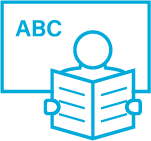


The aim of this study was to investigate which working memory and long-term memory components predict vocabulary learning. Short, phonologically native nonwords were learned best. Phonological sensitivity predicted learning of all nonword types (except short native nonwords), vocabulary predicted learning of only short native nonwords, and central attentional resources predicted learning of short nonwords (but not long nonwords).
Authors: Sergio Morra & Roberta Camba
Source: Morra, S. & Camba, R. (2009). Vocabulary learning in primary school children: Working memory and long-term memory components. Journal of Experimental Child Psychology, 104, 156–178. doi:10.1016/j.jecp.2009.03.007
The aim of this study was to investigate which working memory and long-term memory components predict vocabulary learning. A nonword learning paradigm was used in which children aged 8–10 years learned picture–nonword pairs. The nonwords varied in length and phonology. Short phonologically native nonwords were learned most effectively. Linear structural equation analyses demonstrated the influence of three constructs: phonological sensitivity, vocabulary knowledge, and central attentional resources on nonword learning. Phonological sensitivity predicted learning of all nonword types (except short native nonwords), vocabulary predicted learning of only short native nonwords, and central attentional resources predicted learning of short nonwords (but not long nonwords).
M capacity

Study
In this study, it is hypothesised that the construct of phonological memory could be deconstructed into three components: phonological sensitivity, attentional resources (M capacity), and rehearsal. The role of the predictors is likely to vary according to the different materials to be learned.
Participants were 161 elementary school children in Italy with a mean age of 9 years 8 months.

Findings

Conclusions and implications
The results of this study support the view that vocabulary learning cannot be accounted for by a single mechanism; instead, a cognitive system with several components is involved. The relative importance of these different components may vary depending on the characteristics of the words being learned. Consistent with the hypotheses, the predictor latent variables that represent the cognitive system involved in learning include both long-term memory and working memory components. Phonological memory can be decomposed into phonological sensitivity, rehearsal efficiency, and M capacity.